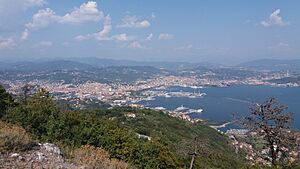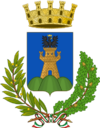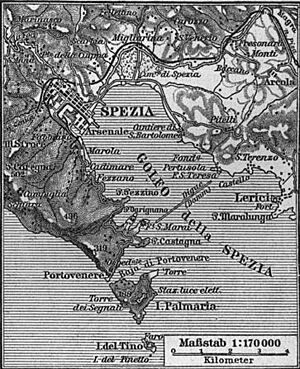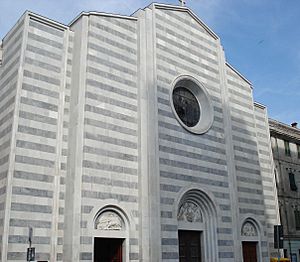La Spezia facts for kids
Quick facts for kids
La Spezia
A Spèza (Ligurian)
|
|||
|---|---|---|---|
| Comune della Spezia | |||

Panorama of La Spezia
|
|||
|
|||
| Country | Italy | ||
| Region | Liguria | ||
| Province | La Spezia (SP) | ||
| Frazioni | Biassa, Cadimare, Campiglia, Fabiano Alto/Coregna, Isola di Felettino, Marinasco/Sarbia, Marola, Pitelli, San Venerio/Carozzo | ||
| Area | |||
| • Total | 51 km2 (20 sq mi) | ||
| Elevation | 10 m (30 ft) | ||
| Population
(31 December 2019), "La Spezia 2019"
|
|||
| • Total | 93,288 | ||
| • Density | 1,829/km2 (4,740/sq mi) | ||
| Demonym(s) | Spezzini | ||
| Time zone | UTC+1 (CET) | ||
| • Summer (DST) | UTC+2 (CEST) | ||
| Postal code |
19100, 19121–19126, 19131–19139
|
||
| Dialing code | 0187 | ||
| Patron saint | St. Joseph | ||
| Saint day | 19 March | ||
La Spezia is a cool city in Italy. It's the capital of the province of La Spezia. You can find it at the top of the Gulf of La Spezia. This gulf is in the southern part of the Liguria region.
La Spezia is the second-biggest city in the Liguria region. Only Genoa is larger. It sits right between Genoa and Pisa on the Ligurian Sea. It's a super important port for both military ships and trade. It's also a big base for the Italian Navy. People love to visit this seaside city. It's also a major train hub. You can explore its museums, watch the Palio del Golfo rowing race, or take trains and boats to the amazing Cinque Terre.
Contents
A Look at La Spezia's Past
People have lived in La Spezia and its area for a very long time. Even before recorded history! In Roman times, a major town called Luni was nearby. La Spezia was briefly the capital for a ruler named Niccolò Fieschi from 1256 to 1273. Because of this, its history is tied to Genoa.
After the Republic of Genoa ended in 1797, La Spezia kept growing. It developed in ways similar to Genoa. You can still see Genoa's influence in the city's design. This includes the narrow street called Via del Prione. It's named after a large stone (prione in local language). Public announcements used to be read out there.
How La Spezia Grew
La Spezia really started to grow after 1861. That's when the big naval shipyard was built there. The Royal government ordered its construction. In September 1943, Italy surrendered to the Allies. The Italian Navy was told to sail from La Spezia to Malta. The German forces arrived too late to stop the fleet from leaving.
During the war, Italian troopships also left from La Spezia. One ship, the Kaiser Franz Josef, was sunk in La Spezia harbor in 1944.
Gateway to Hope
After the war, La Spezia became a starting point for people who survived the Nazi concentration camps. From 1945 to 1948, over 23,000 Jewish displaced persons secretly left Italy from here. They were heading for Palestine. Because so many people left from the Gulf of La Spezia, it's called Shaʿar Zion on Israeli maps. This means "Gateway to Zion" in Hebrew.
What to See in La Spezia
Churches to Visit
- Cristo Re dei Secoli: This is a modern cathedral. It was finished in 1975.
- Abbey church of Santa Maria Assunta: This church is from the 1200s. It has many cool artworks inside. Some of these artworks used to be in other religious buildings. You can see an Incoronation of the Virgin by Andrea della Robbia here.
- Santi Giovanni e Agostino: This church has a single main room. It's decorated with art from the 1700s and 1800s.
- Nostra Signora della Scorza: Built in 1900, this church is in Piazza Brin.
- Maria Ausiliatrice: This church was built in the second half of the 1900s.
- Nostra Signora del Pianto: This small church has an image of the Virgin Mary. People believe it's part of a sad story. Its special day is Pentecost.
Cool Museums to Explore
- Ubaldo Formentini—Civic Museum: This museum is inside the Castle of San Giorgio.
- Amedeo Lia Museum: Check out the art here.
- Palazzina delle Arti and Museum of Seals: Learn about art and old seals.
- Museum of Modern and Contemporary Art (CAMeC): See modern and new art.
- Diocesan Museum: Discover religious art and history.
- Ethnographic Civic Museum: Learn about local culture and traditions.
- Technical Naval Museum: Explore the history of the navy.
- National Transportation Museum: See how people and goods have moved around.
- Museum of Radio Electronics and Telecommunications: Learn about old radios and phones.
- Galleria ex Ricovero Antiaereo Quintino Sella: An old air raid shelter turned into a gallery.
Other Interesting Places
- Castle of San Giorgio: This castle has been fixed up. It might have started as a watchtower. A castle was first built here in 1262. It was destroyed in 1273. A new one was built starting in 1371. The Republic of Genoa added another part in 1607.
- Public Gardens: A nice place to relax outdoors.
- Art Nouveau—style villas: See beautiful old houses with unique designs.
- Futurist mosaic: Look for this cool artwork by Prampolini inside the Post Office.
- La Spezia is a great starting point for visiting the Cinque Terre villages. You can go by train or boat. The boat also stops at Lerici and Portovenere. The Cinque Terre villages are about 15 kilometres (9 mi) from the main train station.
La Spezia's Weather
La Spezia has a mix of humid subtropical and Mediterranean weather. This means it has hot summers. Winters are chilly and wet. Spring and autumn can be very rainy and change quickly.
Temperatures and Rain
In January, the coldest month, temperatures are about 4 °C (39 °F) at their lowest. They reach about 11 °C (52 °F) at their highest. In July, the hottest month, the lowest temperatures are around 20 °C (68 °F). The highest are about 29 °C (84 °F). La Spezia gets a lot of rain, about 1,314 millimetres (51.7 in) each year. That's more than double the rain in London!
Snow is very rare here. Heavy snowfalls are super unusual. In 1985, over 50 centimetres (20 in) of snow fell. Another big snowfall happened in December 2009. About 25 centimetres (9.8 in) of snow fell. Temperatures dropped to −7.4 °C (18.7 °F) that night.
On clear winter nights, temperatures can drop below freezing. They usually reach about −2 to −4 °C (28 to 25 °F). In summer, especially on sunny days, it can easily get hotter than 30 °C (86 °F). Sometimes it even reaches 35 °C (95 °F). The high humidity in summer makes it feel even hotter.
Winds and Their Impact
Because of how the city is built, it's protected from winds coming from the north. But it does get winds from the southeast. These winds can bring heavy rain. They can also be very strong, sometimes reaching 80 kilometres per hour (50 mph). In rare cases, they can even cause the port to close. The only northern wind that reaches the city is the Grecale. This wind comes from the northeast. It happens when cold air from the Arctic flows over the warmer Tyrrhenian Sea. This creates low pressure. It also pulls colder, heavier air from the Po Valley, which is behind the Apennine Mountains.
| Climate data for La Spezia | |||||||||||||
|---|---|---|---|---|---|---|---|---|---|---|---|---|---|
| Month | Jan | Feb | Mar | Apr | May | Jun | Jul | Aug | Sep | Oct | Nov | Dec | Year |
| Mean daily maximum °C (°F) | 11.0 (51.8) |
11.9 (53.4) |
14.5 (58.1) |
18.1 (64.6) |
22.3 (72.1) |
26.0 (78.8) |
28.9 (84.0) |
28.2 (82.8) |
25.3 (77.5) |
20.8 (69.4) |
15.7 (60.3) |
12.7 (54.9) |
19.6 (67.3) |
| Mean daily minimum °C (°F) | 4.2 (39.6) |
4.7 (40.5) |
6.8 (44.2) |
10.3 (50.5) |
13.7 (56.7) |
17.4 (63.3) |
19.7 (67.5) |
19.4 (66.9) |
16.9 (62.4) |
13.1 (55.6) |
8.8 (47.8) |
5.9 (42.6) |
11.7 (53.1) |
| Average precipitation mm (inches) | 120 (4.6) |
110 (4.3) |
110 (4.5) |
130 (5.0) |
58 (2.3) |
51 (2.0) |
36 (1.4) |
53 (2.1) |
84 (3.3) |
170 (6.5) |
200 (7.9) |
200 (7.9) |
1,320 (51.8) |
| Source: Enea | |||||||||||||
| Historical population | ||
|---|---|---|
| Year | Pop. | ±% |
| 1861 | 15,330 | — |
| 1871 | 26,753 | +74.5% |
| 1881 | 36,046 | +34.7% |
| 1901 | 73,603 | +104.2% |
| 1911 | 77,543 | +5.4% |
| 1921 | 100,383 | +29.5% |
| 1931 | 115,118 | +14.7% |
| 1936 | 106,119 | −7.8% |
| 1951 | 111,849 | +5.4% |
| 1961 | 121,923 | +9.0% |
| 1971 | 124,547 | +2.2% |
| 1981 | 115,392 | −7.4% |
| 1991 | 101,442 | −12.1% |
| 2001 | 91,391 | −9.9% |
| 2011 | 92,659 | +1.4% |
| 2021 | 92,169 | −0.5% |
| Source: ISTAT | ||
Famous People from La Spezia
Many talented people come from La Spezia! Here are a few:
- Alessia Aquilani (born 1967), known as Alexia, a singer.
- Toto Cutugno (1943–2023), a famous singer.
- Giancarlo Giannini (born 1942), a well-known actor.
- Virginia Oldoini (1837–1899), the Countess of Castiglione.
- Alessandro Petacchi (born 1974), a professional cyclist.
- Lorenzo Richelmy (born 1990), an actor.
La Spezia's Economy
Today, La Spezia is Italy's main naval base and shipyard. It also has a special school for navy navigation. It's a busy port for trade. Industries here make machines, metal products, and refined oil.
Getting Around La Spezia
Buses and Trolleybuses
ATC La Spezia manages all public transport. This includes city buses, buses that go to nearby towns, and the local trolleybus system.
Railway Stations
The main train stations in La Spezia are La Spezia Centrale railway station, Migliarina railway station, and Ca' di Boschetti.
Learning in La Spezia
Since 2002, a university called G. Marconi has been in La Spezia.
The Distretto Ligure delle Tecnologie Marine (DLTM) is a research center. It focuses on the "blue economy," which means using the ocean's resources in smart ways. It's a team of over 20 groups. These include big companies like Fincantieri and Leonardo S.p.A.. It also includes the CNR and the University of Genoa. Both the "G. Marconi" university and the DLTM are in the old Bruno Falcomatà hospital building.
Sports in La Spezia
In 2020, the local football (soccer) team, Spezia Calcio, made history! They were promoted to the Serie A for the very first time. This is Italy's top football league.
La Spezia Around the World
La Spezia has "twin city" relationships with other cities around the world. This means they share culture and friendship.
Images for kids
See also
 In Spanish: La Spezia para niños
In Spanish: La Spezia para niños










